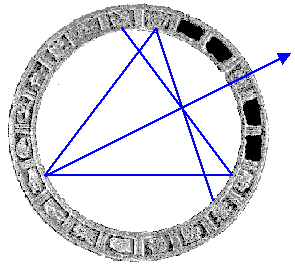Earth/matriX
SCIENCE IN ANCIENT
ARTWORK
The 9 baktuns of the
9.0.0.0.0
Baseline of maya History on
the Aztec Calendar,
(Stela 63 at Copán),
By
Charles William Johnson
Stela 63 at Copán
Recently, stela 63
was discovered at Copán by Palka and Richard Williamson (Cfr., Michael Coe, Scribes, Warrios and Kings, 1991). Upon this stela
is sculpted the maya base-line date of 9.0.0.0.0, ( 9 baktuns,
0 katuns, 0 tuns, 0 uinals, 0 kins), which
according to author Coe, ..., "the subsequent rules took this [date]
to be the base-line of their dynastic history" (Ibid., p.84). Such
is the historical significance of this particular date within the maya history registered at Copán. But, there may be more.
Authors like Hugh
Harleston, Jr. contend that the culture of Teotihuacan was that of the
proto-maya. In our analyses, we have shown how the pyramidal site of Teotihuacan may have been linked to the design within the Aztec Calendar (Cfr.,
Earth/matriX Nº 7). The case may be that the maya long count is also etched upon the face of the Aztec Calendar, as we have been observing
a close relatonship between the numerical series implied in that count
and the design elements within the Aztec Calendar. We have recenty identified
possible starting points for the Aztec Calendar which begin/end at the
mouth and tails of the ring of serpentes.
The Beginning/Ending of the Ring of Serpents on the Aztec Calendar

If we then begin the count as of the first segment of the body of the
serpent on the right side of the image of the Aztec Calendar, and count
off nine segments thereof, the following relationship appears:
The First Nine Segments of a Cycle

When the segments
of the serpents are thus considered to represent one baktun (144,000
days), then the ninth segments becomes noteworthy in and as of the very
design of the Aztec Calendar itself. The day-glyph of the seventeenth
day (ollin) ![]() appears to be pointing directly at the line that ends the ninth segment
on the ring of serpents. In fact, the same segmentation is mirrored on
the other side of the ring of serpents in this manner, marking off 9 baktuns on the serpent of the left side.
appears to be pointing directly at the line that ends the ninth segment
on the ring of serpents. In fact, the same segmentation is mirrored on
the other side of the ring of serpents in this manner, marking off 9 baktuns on the serpent of the left side.
The 9 Baktuns on the Rings of Serpents and the Ollin Marker
with Corresponding Day-count Numbers

Thus, the forzen
image of the Aztec Calendar may be set at the maya long count base
line date of 9.0.0.0.0., given the suggested direction of the ollin marker. and the fixed position of the remaining rings. Note that 1296000 days represents .6923076 percent of the maya long count
period of 1872000 days. The particular cycle-count of 1296000
days also represents an histotically significant count of the ancient kemi. Furthermore, the .6923076 percentile is significant among
distinct ancient reckoning numbers and cycle counts:
for example, 252 / 364 = .6923076; 567 / 819 = .6923076; 288 / 416 = .6923076;
etc.
The fact that the segments within the ring of serpents may represent thirtten units is in itself significant for the ancient reckoning system based on a 13-count (13c). But, to also observe a marker-like glyph, the ollin, at precisely the coordinate line that divides the serpent's body between nine and thirteen segments, suggests a conscious design . We the should remember our previous analysis (Cfr., Earth/matriX Nº 2), where we illustrated the relationship between the ollin glyph on the day-ring and the month quecholli, thus indicating possibly the aggregate days (los acompañados), which correspond to the remaining 10 days of the 364c day-count.

The significance
of the base-line is best expressed in the words of author Michael Coe:
"This momument
[Stela 63] was carved as a retrospective commemoration of the completion
of one of the most important calendrical cycles for the maya, the baktun,
or period of 400 approximate (360-day) years. In this case the stela marks
the completion of the 9th baktun since the beginning of the present era,
calculated to have begun in the year 3114 BC. This 'Period Ending' was
a particulary important one, akin to what the years AD 2000 will be for
Western civilization; a time-marker, a point at which to pause and reflect
on one's achievements as well as one's challenges for the future". (ibid.,
p.81)
Once again, we observe
a direct relationship among the three main elements considered in our
studies; the mathematics, the geometry and the design elements of the ancient artwork. The ancient reckoning system's numbers
correspond to the spatial divisions, and these in turn are marked off
by significant elements within the design, generally historically significant
glyphs and symbols.
Reproduction prohibited without written consent of the author.
Your comments
and suggestions are greatly appreciated:
e-mail: johnson@earthmatrix.com
Science in Ancient Artwork
Extract Nº.22
The 9 baktuns of the 9.0.0.0.0 Baseline of maya History on the Aztec Calendar
28 October 1997
©1997-2012 Copyrighted by Charles William Johnson. All Rights Reserved
Earth/matriX,
| Home | Forum | Reviews | Links | Author | Site Map |